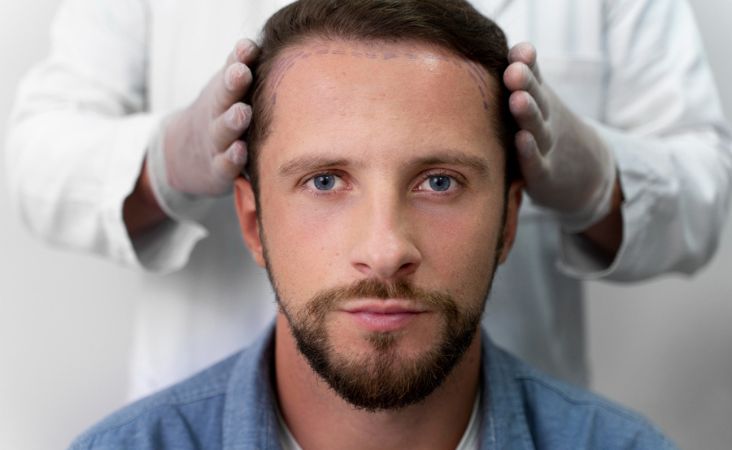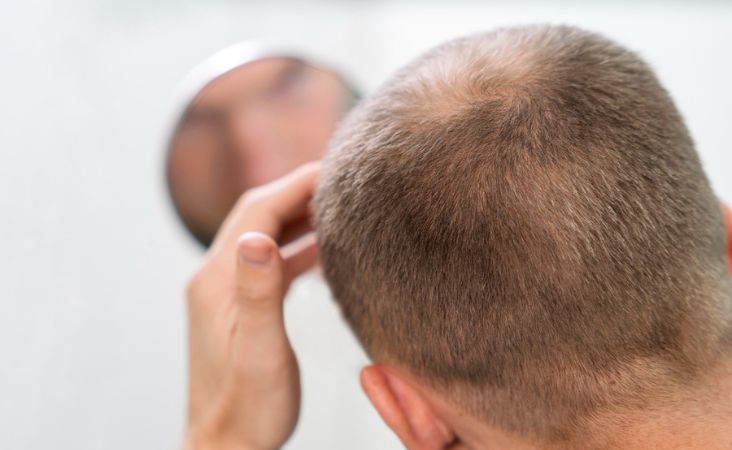Synthetic Hair Transplant: Meaning, Cost, Risks, and Better Alternative
- Written by Vivek Khullar
- | Published Apr 25, 2024
- |
- 7 min read
 Listen to the full text
Listen to the full textHair loss is stressful for both men and women. Thankfully, there are numerous solutions to combat this issue in 2024. From non-surgical products like toupees to advanced surgical techniques, there’s something for everyone with hair thinning or bald patches! But one method that has recently sparked intrigue among many is synthetic hair transplant. Questions like below are pretty common:
What exactly is synthetic hair transplant about?
How does synthetic hair transplant work?
Are there any risks involved?
And most importantly, is it the right choice for you?
We know you have so many questions to ask. Don’t worry, Lordhair has the answers! In this blog, we will tell you everything important about synthetic hair transplant. By the end of this read, you’ll be fully equipped to decide whether the method aligns with your hair recovery goals.
What is a Synthetic Hair Transplant?
A synthetic hair transplant is a cosmetic procedure that addresses hair loss by implanting artificial fibers directly into the scalp. Yes, no more taking hair from other parts of your body and moving them to the scalp! This method relies on pre-made strands crafted from biocompatible materials. Typically a form of high-grade nylon or polyester.
These synthetic fibers are designed to mimic the look and feel of natural hair. They come in different colors and textures to achieve a natural-looking outcome. The synthetic hair implantation process involves a minimally invasive procedure. After a thorough consultation and scalp analysis to determine candidacy and desired density, dermatologists will apply a local anesthetic to numb the affected area.
Using a specialized implantation device, they will meticulously insert individual synthetic fibers into the scalp. Each fiber possesses a tiny anchor at its tip. This makes it easy for dermatologists to secure it within the targeted recipient site. The meticulous placement of synthetic hair also guarantees they seamlessly blend with your existing hair while maintaining a natural direction and growth pattern.
The entire procedure is typically performed on an outpatient basis. Meaning, you can return home the same day.

How is Synthetic Hair Transplant Different from Traditional Method?
Yes, hair loss recovery solutions have come a long way but traditional hair transplants and synthetic fiber transplants work on very different principles.
Here's a breakdown of the key distinctions between these two methods:
#1 Source of hair
The cornerstone of traditional hair transplants lies in utilizing your own hair follicles. Hair is typically harvested from a donor area. Often the back or sides of the scalp where hair growth is generally resistant to balding. These extracted follicles are then meticulously transplanted into the recipient's balding areas.
Synthetic hair transplants bypass the need for donor hair altogether. Instead, they rely on pre-made fibers constructed from biocompatible synthetic materials (as mentioned above). These fibers are designed to resemble natural hair in appearance and texture.
#2 Procedure and recovery
Okay, what’s the first thing that comes to your mind when you hear the word “hair transplant?” Of course, removal of hair from one part of the scalp and moving it to the other. But you know traditional hair recovery surgeries are categorized into two primary techniques i.e. Follicular Unit Transplantation (FUT) and Follicular Unit Extraction (FUE).
FUT involves the surgical removal of a strip of scalp tissue containing healthy hair follicles. This strip is then dissected into individual follicular units for transplantation. FUE, on the other hand, is about extracting individual follicular units directly from the donor area using a specialized tool.
Both procedures require some degree of downtime for healing and scalp sensitivity post-surgery. Talking about the synthetic hair transplant procedure, well, it is minimally invasive and generally performed on an outpatient basis.
Anesthetic is applied to numb the area and then specialized implantation tools are used to precisely insert individual synthetic fibers into the scalp. The procedure is relatively quick and often completed within a few hours. Recovery time is considerably shorter compared to traditional transplants.
Make sure to check out these sources as well:
Learn about derma rolling for hair loss
Here’s how to repair damaged hair fast at home
Everything about diffuse hair thinning in men
Best non-surgical hair restoration methods
Learn how to repair damaged hair fast
#3 Suitability
Of course, there would be no point of comparison if we didn’t talk about this aspect! Traditional hair transplants are ideal for individuals with healthy donor areas. It’s also for those who desire a permanent, natural-looking hair restoration solution. All they need to do is consult with a qualified hair transplant surgeon to assess candidacy and determine the most suitable technique based on their specific hair loss pattern and goals.
Synthetic hair transplants, on the other hand, might be a suitable option for all types of individuals. Yes, this also includes those who have limited donor hair availability or those seeking a quicker, less invasive solution for hair loss. It can also be an alternative for those who are hesitant about the surgical nature of traditional transplants.
What is the Cost of Synthetic Hair Transplant?
Now that you have a clear understanding of the procedure and its key differences from traditional transplants, let's delve into the cost aspect! It's important to note that there's no single price tag for synthetic hair transplants. The overall cost can vary depending on several factors. However, Lordhair can provide you with an average range to set realistic expectations.
On average, synthetic hair transplants can range from US$6,000 to US$15,000. Here's a breakdown of some key factors that impact the cost of this type of hair recovery method for men and women:
Number of fibers: The number of synthetic fibers needed for a successful outcome is a primary cost driver. This number will depend on the severity of your hair loss and the desired level of hair density. A consultation with a hair transplant specialist will help determine the exact number of fibers required for your specific case.
Surgeon's expertise: The experience and qualifications of the surgeon performing the procedure can also influence the cost. Board-certified surgeons with extensive experience in synthetic hair transplants may command a higher fee compared to less experienced practitioners.
Clinic location: Another factor that plays a crucial role in cost variation is geographical location. Clinics situated in major cities with a higher cost of living might have slightly higher prices compared to those in suburban or rural areas.
While synthetic hair transplants might seem like a more affordable option compared to traditional methods at first glance, it's important to consider the long-term cost. Unlike the former method, results driven by the latter hair recovery technique are not permanent. Over time, one may require touch-up procedures or even complete replacement, adding to the overall expense.

What are Risks of Synthetic Hair Transplant?
You see, in the world of science, every solution comes with a set of considerations. Synthetic hair transplant, while offering a quicker and less invasive approach to hair restoration, is not without its potential downsides.
Here's a closer look at some of the associated risks to consider before making an informed decision:
Foreign body response: A human body is naturally programmed to recognize and defend against foreign objects. When synthetic fibers get implanted into the scalp, they might be perceived as one. This triggers an immune response and can lead to inflammation, redness, and discomfort at the implantation sites.
In severe cases, the body might attempt to reject the fibers entirely, causing them to fall out prematurely.
Allergic reactions: Some individuals might be allergic to the specific materials used in the synthetic fibers. This can manifest as itching, irritation, and even blistering around the implantation sites. It is advised to ask your dermatologist to do patch testing before the procedure. This will help you identify any potential allergies and mitigate this risk.
Improper technique: Like any surgical procedure, synthetic hair transplants carry a risk of infection if not performed under sterile conditions or with proper hygiene practices. Although this risk can be minimized by choosing a qualified and experienced surgeon who adheres to strict infection control protocols, there may still be a fear of things going wrong during the treatment.
Scarring: Yes, you read it right! Scarring can also occur in rare cases. Particularly if the implantation technique is overly aggressive or if the body rejects the fibers. While scarring is usually minimal, it's important to be aware of this potential complication.
Limited customization: While available in various colors and textures, Synthetic fibers might not always perfectly match the characteristics of natural hair in some men and women. They can lead to a less natural-looking outcome, particularly when compared to transplanted hair follicles that grow and adapt over time.
Fiber breakage and loss: Okay, we did tell you that synthetic fibers are not permanent. But now let’s talk about it in detail! Over time, strands can become brittle and break, requiring replacements to maintain hair density. Additionally, they might loosen or fall out due to daily activities like combing and washing your hair.
This necessitates touch-up procedures or even complete re-implantation, adding to the overall cost and potentially impacting the long-term aesthetics.
Newer technology: Another risk to consider is that synthetic hair transplants are a relatively new technology compared to traditional hair transplants. As such, long-term studies on their safety and efficacy are still ongoing. While initial research appears promising, it's important to acknowledge the lack of extensive data regarding the potential long-term effects of synthetic fibers on the scalp and surrounding tissues.
Unrealistic expectations: Synthetic hair transplants can offer a significant improvement in hair density - no doubt. However, it's crucial to have realistic expectations. To be precise, the results you’ll get might not be identical to natural hair growth. Also, the need for touch-up procedures can be discouraging for some men and women.

What is a Better Alternative to Synthetic Fibre Hair Transplant?
Given the potential risks associated with synthetic hair transplants, of course, your natural instinct might be to seek a treatment that's not only pain-free but also has zero side effects. *Enter hair systems* A revolutionary solution for achieving a full head of hair without the drawbacks of surgical procedures.
But what exactly are hair systems? Imagine a base crafted from top-notch materials with high-quality human hair strands woven into it. This creates a natural-looking, comfortable piece that seamlessly integrates with your existing hair.
Hair systems offer a plethora of benefits over synthetic transplants which makes them a compelling choice for men and women seeking a non-invasive hair restoration solution. Here's why buying a non-surgical hair replacement from Lordhair makes perfect sense:
Unmatched customization: Unlike "one-size-fits-all" solutions, Lordhair prioritizes customization. We offer a vast selection of hair systems crafted from various human hair types. Luxurious Indian hair, silky European hair, or even virgin hair with intact cuticles for unparalleled realism.
Whether you crave cascading curls, sleek straight styles, or anything in between, our extensive catalog allows you to achieve your desired look effortlessly.
Ready-to-wear convenience: Forget the hassle of styling after receiving your hair system. We understand the desire for immediate results. That's why we offer ready-to-wear hair units, where our stylists create your dream hairstyle at our studio and ship it afterward. Meaning, you can take your new hair system straight out of the box, put it on your head, and feel confident with minimal effort.
Unwavering quality: At Lordhair, quality is paramount. We meticulously craft our hair systems using only 100% human hair, ensuring a natural look and feel. From luxurious Indian Remy hair to virgin hair with intact cuticles, we offer a range of options to meet your specific needs and preferences.
Unbeatable prices: As a global online retailer with our own factory, Lordhair eliminates unnecessary middleman costs. For you, this translates to significant SAVINGS! We believe everyone deserves access to premium hair solutions without breaking the bank.
Trusted by thousands: Don't just take our word for it. Thousands of men and women across the globe trust Lordhair for their toupee hair replacement system needs. Check out Tim's story and countless others to see how Lordhair has transformed lives with confidence-boosting hair systems.
Synthetic Hair Transplant: Final Words
There you go! We've answered all the important questions regarding synthetic hair transplants in 2024. Remember, the decision is ultimately yours. We are not saying that going with this hair recovery method is not good for you. We simply want you to be fully informed about the process, potential risks, and alternative options available.
For those seeking a quicker and safer solution to achieve a full head of hair, consider exploring Lordhair's extensive collection of hair systems. We offer a variety of natural-looking, high-quality men’s hairpieces and women's wigs crafted from 100% human hair.
With unmatched customization options, ready-to-wear convenience, and exceptional customer service, Lordhair empowers you to rediscover your confidence and embrace a full head of beautiful hair.
Contact us today in case of queries!



